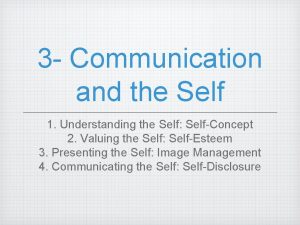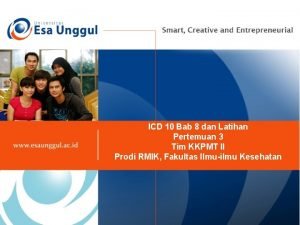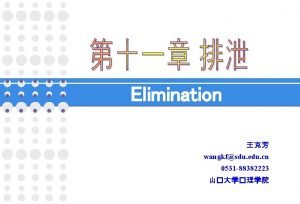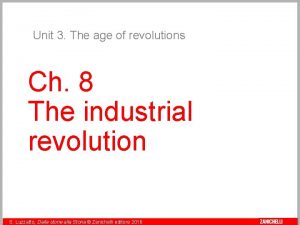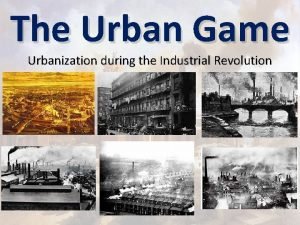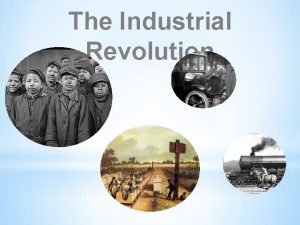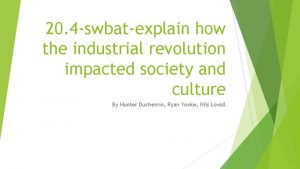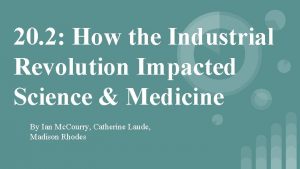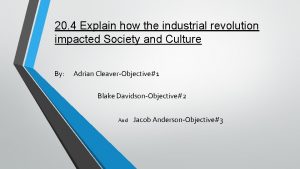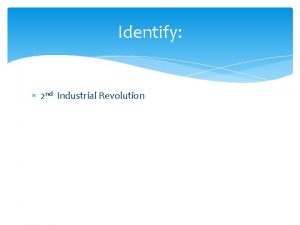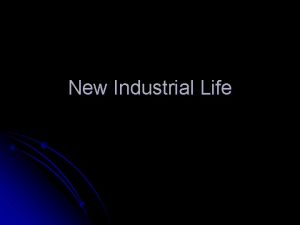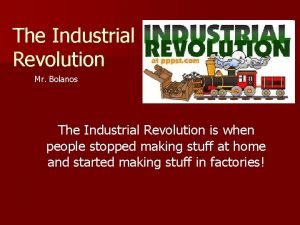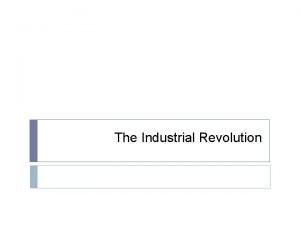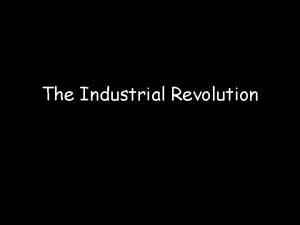Identify one way the Industrial Revolution impacted the



























- Slides: 27

�Identify one way the Industrial Revolution impacted the environment. DO NOW

How are the environment and economics interrelated?

�The law of supply and demand is based on the ratio of how much there is of something, and how much that something is needed or wanted. SUPPLY AND DEMAND

�The law of supply and demand is based on the ratio of how much there is of something, and how much that something is needed or wanted. �High demand: ◦ The more there is, the less its cost/value SUPPLY AND DEMAND

�The law of supply and demand is based on the ratio of how much there is of something, and how much that something is needed or wanted. �High demand: ◦ The more there is, the less its cost/value ◦ The less there is, the more its cost/value SUPPLY AND DEMAND

�A cost/benefit analysis is the ratio of the price of doing something and the benefits of doing it. COST AND BENEFITS

�A cost/benefit analysis is the ratio of the price of doing something and the benefits of doing it. ◦ High cost/high benefit: will be done COST AND BENEFITS

�A cost/benefit analysis is the ratio of the price of doing something and the benefits of doing it. ◦ High cost/high benefit: will be done ◦ High cost/low benefit: will not be done COST AND BENEFITS

�A cost/benefit analysis is the ratio of the price of doing something and the benefits of doing it. ◦ High cost/high benefit: will be done ◦ High cost/low benefit: will not be done ◦ Low cost/high benefit: will be done COST AND BENEFITS

�A cost/benefit analysis is the ratio of the price of doing something and the benefits of doing it. ◦ High cost/high benefit: will be done ◦ High cost/low benefit: will not be done ◦ Low cost/high benefit: will be done ◦ Low cost/low benefit: may or may not be done COST AND BENEFITS

�Part of the cost/benefit analysis RISK ASSESSMENT

�Part of the cost/benefit analysis �Analyzes the non-financial risks associated with an action. RISK ASSESSMENT

�Part of the cost/benefit analysis �Analyzes the non-financial risks associated with an action. ◦ High risk; less likely to do RISK ASSESSMENT

�Part of the cost/benefit analysis �Analyzes the non-financial risks associated with an action. ◦ High risk; less likely to do ◦ Low risk; likely to do RISK ASSESSMENT

�Developed countries DEVELOPING COUNTRIES

�Developed countries ◦ High income ◦ Low population growth DEVELOPING COUNTRIES

�Developed countries ◦ High income ◦ Low population growth ◦ Diverse economies ◦ Strong social supports DEVELOPING COUNTRIES

�Developed countries ◦ High income ◦ Low population growth ◦ Diverse economies ◦ Strong social supports �Developing countries DEVELOPING COUNTRIES

�Developed countries ◦ High income ◦ Low population growth ◦ Diverse economies ◦ Strong social supports �Developing countries ◦ Low incomes ◦ Agriculture based economy DEVELOPING COUNTRIES

�Developed countries ◦ High income ◦ Low population growth ◦ Diverse economies ◦ Strong social supports �Developing countries ◦ Low incomes ◦ Agriculture based economy ◦ Rapid population growth DEVELOPING COUNTRIES

�Local population pressures: are there enough resources to support growth? Population and Consumption

�Local population pressures: are there enough resources to support growth? �Consumption trends: how much resource is being used? Population and Consumption

�Local population pressures: are there enough resources to support growth? �Consumption trends: how much resource is being used? ◦ The developed nations use 75% of the resources with only 20% of the population Population and Consumption

�Local population pressures: are there enough resources to support growth? �Consumption trends: how much resource is being used? ◦ The developed nations use 75% of the resources with only 20% of the population �Ecological footprint: how much land is needed to support one person? Population and Consumption

�When human needs are being met so that the population can survive indefinitely, the conditions are considered sustainable. SUSTAINABILTY

�In groups, explain sustainability and the differences in how a developed and developing country might approach the problem of sustainability. ACTIVITY

�Text page 21, question 4. HOMEWORK
 Relative frequency two way table
Relative frequency two way table Two way anova
Two way anova Threaded binary tree in data structure
Threaded binary tree in data structure Perbedaan one way dan two way anova
Perbedaan one way dan two way anova What does one way anova tell you
What does one way anova tell you One way anova vs two way anova
One way anova vs two way anova Two way anova adalah
Two way anova adalah The way one wishes to be perceived by others is one's .
The way one wishes to be perceived by others is one's . Kode icd 10 meniere's disease
Kode icd 10 meniere's disease How has the printing press impacted society
How has the printing press impacted society Why is canada rarely impacted by natural weather hazards
Why is canada rarely impacted by natural weather hazards Quality of education can be impacted by mcq
Quality of education can be impacted by mcq Kelsey fry technique
Kelsey fry technique Archer's classification impacted canines
Archer's classification impacted canines Fecal impaction
Fecal impaction Impacted stool symptoms
Impacted stool symptoms Russian revolution vs french revolution
Russian revolution vs french revolution How could the french revolution been avoided
How could the french revolution been avoided The third agricultural revolution
The third agricultural revolution Enclosure movement
Enclosure movement Why did the industrial revolution start in britain
Why did the industrial revolution start in britain An age of revolutions zanichelli
An age of revolutions zanichelli The urban game
The urban game Enclosure movement industrial revolution
Enclosure movement industrial revolution When was the loom invented
When was the loom invented Industrial revolution transition
Industrial revolution transition Industrial revolution quiz
Industrial revolution quiz Industrial revolution powerpoint
Industrial revolution powerpoint







